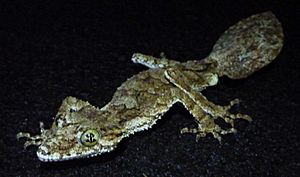Northern leaf-tailed gecko facts for kids
The northern leaf-tailed gecko (Saltuarius cornutus) is a special type of gecko found in Australia. It belongs to a group called Saltuarius, known as the Australian leaf-tailed geckos. These geckos are famous for their amazing camouflage, which helps them blend in with their surroundings.
Quick facts for kids Northern leaf-tailed gecko |
|
|---|---|
 |
|
| Conservation status | |
| Scientific classification | |
| Genus: |
Saltuarius
|
| Species: |
cornutus
|
| Synonyms | |
|
Gymnodactylus cornutus Ogilby, 1892 |
|
Contents
Appearance and Features
The northern leaf-tailed gecko is a large gecko. It has a triangular head and a thin neck. Its body can grow up to 14 centimeters long. It also has a wide, leaf-shaped tail about 8 centimeters long.
Unlike many geckos, this one has clawed toes. It does not have sticky pads on its feet. This helps it climb trees, which is where it spends most of its life. Its body is flat, and its legs are long and thin.
The gecko's back has sharp, pointed bumps. These bumps look like small horns. This is why its scientific name, Saltuarius cornutus, means "Horned Keeper of the Forest." Its skin color helps it blend in perfectly. It looks like tree bark covered in lichen. This makes it very hard to spot!
Where They Live
Habitat of the Northern Leaf-Tailed Gecko
The northern leaf-tailed gecko lives in warm places. It prefers tropical rainforests and wet sclerophyll forests. These are forests with tough, dry-leaved plants. You can usually find them above 750 meters in height.
They live in the Coastal and Great Dividing Ranges. These mountain ranges are in northeastern Queensland. Their habitat stretches south into New South Wales, near Taree.
Behavior and Life Cycle
Nighttime Activity
These geckos are active at night. They also like cool weather. Most other reptiles rest when it's cool. But the northern leaf-tailed gecko is often out and about.
Defense Mechanisms
When this gecko feels threatened, it has special ways to protect itself. It will arch its back and raise its tail. It also wags its tail from side to side. This tries to make an attacker focus on the tail, not its head.
If it gets attacked, it can drop its tail very easily. This is called autotomy. A new tail will grow back. However, the new tail will be wider and flatter. It will also have different colors and a short tip.
The gecko might also open its mouth wide. It can even charge at an attacker while making noises.
Reproduction and Eggs
Female geckos lay one or two eggs. These eggs have a soft, parchment-like shell. They lay them in a shallow nest. The nest is usually covered with leaf litter and soil. Sometimes, many females lay their eggs in the same spot. Up to 14 eggs from different females have been found in one shared nest!
What They Eat
Diet of the Northern Leaf-Tailed Gecko
The northern leaf-tailed gecko eats large insects. It also eats other small creatures with exoskeletons, called arthropods. Some of its favorite foods include cockroaches and spiders.
See also
 In Spanish: Saltuarius cornutus para niños
In Spanish: Saltuarius cornutus para niños


